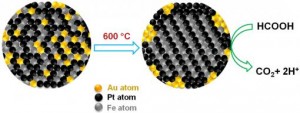Michael Berger has featured Dr. Mingjun Zhang’s team’s fascinating work on flesh-eating fungus in a Dec. 18, 2012 Spotlight article on Nanowerk,
“Most studies on naturally occurring organic nanoparticles have focused on higher organisms,” Mingjun Zhang, an associate professor of biomedical engineering at the University of Tennessee, Knoxville, tells Nanowerk. “Given the earth’s rich biological diversity, it is reasonable to hypothesize that naturally occurring nanoparticles, of various forms and functions, may be produced by a wide range of organisms from microbes to metazoans.”
In his research, Zhang has focused on looking at nature for inspirations for solutions to challenges in engineering and medicine, especially in small-scale, such as bioinspired nanomaterials, bioinspired energy-efficient propulsive systems, and bioinspired nanobio systems for interfacing with cellular systems.
…
In new work, Zhang and his research associate Dr. Yongzhong Wang have turned their focus to Arthrobotrys oligospora, a representative flesh eater with a predatory life stage in the fungal kingdom.
The researchers have published their work in Advanced Functional Materials ((early online publication behind a paywall),
Naturally Occurring Nanoparticles from Arthrobotrys oligospora as a Potential Immunostimulatory and Antitumor Agent by Yongzhong Wang, Leming Sun, Sijia Yi, Yujian Huang, Scott C. Lenaghan, and Mingjun Zhang in Advanced Functional Materials
Article first published online: 4 DEC 2012 DOI: 10.1002/adfm.201202619
Here’s the abstract,
Arthrobotrys oligospora, a representative flesh eater in the fungal kingdom, is a potential source for natural-based biomaterials due to the presence of specialized 3D adhesive traps that can capture, penetrate, and digest free-living nematodes in diverse environments. The purpose of this study is to discover novel nanoparticles that occur naturally in A. oligospora and to exploit its potential biomedical applications. A new culture method, fungal sitting drop culture method, is established in order to monitor the growth of A. oligospora in situ, and observe the nanoparticle production without interfering or contamination from the solid media. Abundant spherical nanoparticles secreted from the fungus are first revealed by scanning electron microscopy and atomic force microscopy. They have an average size of 360–370 nm, with a zeta potential of –33 mV at pH 6.0. Further analyses reveal that there is ≈28 μg of glycosaminoglycan and ≈550 μg of protein per mg of nanoparticles. Interestingly, the nanoparticles significantly induce TNF-α secretion in RAW264.7mouse macrophages, indicating a potential immunostimulatory effect. The nanoparticles themselves are also found slightly cytotoxic to mouse melanoma B16BL6 and human lung cancer A549 cells, and show a synergistic cytotoxic effect upon conjugation with doxorubicin against both cells. This study proposes a new approach for producing novel organic nanoparticles secreted from microorganisms under controlled conditions. The findings here also highlight the potential roles of the naturally occurring nanoparticles from A. oligospora as an immunostimulatory and antitumor agent for cancer immunochemotherapy.
In more generalized language (from Berger’s Spotlight article),
“It is really exciting to use a natural microbe system to produce nanoparticles for potential cancer therapy,” says Zhang. “Originally, we were trying to understand how the fungus secretes an adhesive trap that can capture, penetrate, and digest free-living nematodes in diverse environments. By doing that we almost accidentally discovered the nanoparticles produced.”
…
Zhang’s team investigated the fungal nanoparticles’ potential as a stimulant for the immune system, and found through an in vitro study that the nanoparticles activate secretion of an immune-system stimulant within a white blood cell line. They also investigated the nanoparticles’ potential as an antitumor agent by testing in vitro the toxicity to cells using two tumor cell lines, and discovered nanoparticles do kill cancer cells.
Berger’s article in addition to giving more details about Zhang’s current work and his work with ivy and possible applications for ivy-based nanoparticles in sunscreens also provides some discussion of naturally occurring nanoparticles as opposed to engineered (or man-made) nanoparticles.
The University of Tennessee’s Dec. 4, 2012 press release is also a good source of information on Zhang’s latest work on flesh-eating fungus. For the indefatiguable who are interested in Zhang’s work on ivy and potential nanosunscreens, there’s also my July 22, 2010 posting.

